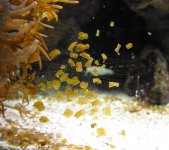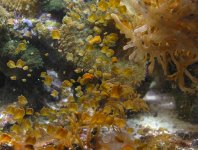Ken I dealt with flatworm questions in my January and July 2002 Aquarium Fish Magazine columns, here are the questions and my replies:
January 2002
I am overwhelmed by flat worms! It looks like I have a
flatworm farm, not a reef tank! What can I do?
Paula F.
via the Internet
Well Paula my immediate reaction would be to recommend you see a
doctor, flatworms can be really nasty, especially when you are
overwhelmed by them!
It is not unusual for a tank to experience an outbreak of flatworms,
especially when newly setup. There is a lot of detritus generated by
new, fresh live rock, and many species of flatworms will feed on this
(other species feed on di
atoms, copepods and some are scavengers).
Eventually they out-strip the food supply, and their numbers drop
rapidly. You can also get outbreaks of the rust coloured species
_Convolutriloba retrogemma_, which may feed on coral slime or surface
tissue and can rapidly reproduce in brightly lit aquariums. Since you
have not indicated what your flatworms look like, e.g. size, colour
and shape, it is difficult to determine what the cause may be of the
outbreak and how to deal with it. There are some fish that may feed on
planaria such at _Anampses_ spp. and _Macropharyngodon_ spp. wrasses,
Šgolden headed sleeper gobies, _Valenciennea strigatus_, and the
psychedelic mandarin fish _Synchiropus picturatus_. Invertebrate
predators include nudibranchs of the genus _Chelidonura_, and snails
such as those in the genera _Thais_ and _Nardoa_. You can also
physically remove the flatworms by siphoning, and depending on the
type of flatworm, using baited traps such as shrimp stuffed in the
foot of a nylon stocking or shining a light on a small area in a
darkened tank and then siphoning them out.
In my experience, flatworm outbreaks may last a few weeks or months,
but eventually they die-off with only a few being spotted on occasion.
July 2002
I have a 90 gallon reef tank that has been up and running for several
years now. I have have been battling tiny (0.5-2 cm) reddish brown
(rust-colored) flatworms for about six months; they are taking over my
aquarium. Several months ago I took out every rock and coral and
dipped it in fresh water. The flatworms seemed to dissolve in the
fresh water, however, now they have returned and are quickly
reproducing. Is there anything I can do to rid my aquarium of these
worms, or at least keep them under control? Although you answered a
similar question in the January 2002 issue of AFM, I did not see any
information on what might eat these red ones. I have tried purple
nudibranchs, several camel shrimp, several peppermint shrimp, an arrow
crab, an elephant snail, a few _Astrea_ snails, lawn mower blenny,
green mandarin goby and a six-line wrasse; all with no real success. At
no point have I witnessed any of these worms being consumed by any of
these fish or invertebrates. The worms are starting to cover my plate
corals and my brain coral cutting off the light and thus killing the
corals. I have also tried siphoning and spotlighting them but they
came back strong after about a week. If they are feeding on coral
slime and surface tissue then and the only way to defeat them is to
let them run out of food then won't they kill all my corals before
they run out of food? Do you have any other ideas? Thank you for your
time.
Chris Brenner, via the Internet
Chris as I mentioned in the January issue of AFM there are some fish
that may feed on planaria such at _Anampses_ spp. and
_Macropharyngodon_ spp. wrasses, the yellow Coris wrasse (_Halichoeres
chrysus_), golden headed sleeper gobies (_Valenciennea strigatus_),
and the psychedelic mandarin fish (_Synchiropus picturatus_).
Invertebrate predators include the nudibranch _Chelidonura varians_
(it has to be this one for the red flatworms, they are very specific
in their feeding habits), and snails such as those in the genera
_Thais_ and _Nardoa_. The shrimp and snails you mentioned will do
nothing to the flatworms you have, as you experienced. You can also
physically remove the flatworms by siphoning or shining a light on a
small area in a darkened tank and then siphoning them out. I should
mention that you have to be persistent with siphoning out the
flatworms, it is not a one time deal, it's something you may have to
repeat as frequently as required until the population does not come
back. It could take months of diligent effort. There have also been
reports that increasing the size/efficiency of protein skimming helps
to eradicate flatworm infestations by presumably removing or reducing
their food supply (detritus, organics?). In addition to siphoning,
increasing the water flow can greatly diminish the flatworm
population. They seem to like low flow areas and by secreting a mucus
net above settled detritus they can all cling together. After
physically removing them, it would help to add what may be an
initially excessive amount of hermit crabs to constantly walk all over
the substrate to prevent them from settling back into the rockwork (J.
Yaiullo, pers. comm.).
In 1994 Julian Sprung and I detailed a number of possible treatments
in _The Reef Aquarium_ volume one, including raising or lowering
specific gravity and pH. We also documented the use of Tetra's Marine
Oomed in German aquariums that contained only _Sarcophyton_ soft
corals. This method has been discussed and used by dozens of hobbyists
on various Internet bulletin boards over the past year. Several
reported that repeated dosages eradicated red flatworms in reef tanks
with stony corals, without seriously harming any other inhabitants.
However, several others reported significant losses of fish and
invertebrates. Therefore, I would recommend that unless you are
completely at your wits end, you not try adding chemicals to your tank
since the results can be unpredictable. If you do decide to try Oomed,
be sure to shut off your protein skimmer, remove any activated carbon
and keep the lights low (otherwise it will be removed or deactivated
quickly). You should see an immediate reaction in the flatworms, they
will appear agitated and move quickly about the aquarium. By the next
day most will be gone if the treatment was effective. Turn on the
skimmer and lights, add a fresh batch of activated carbon and do as
large a water change as is feasible for you. This will not only
removed residual Oomed but also any toxins released by the dead
flatworms. Again, I emphasize that this treatment should not to be
undertaken unless all other methods have been exhausted, including
sustained, manual removal.
Recently a new drug treatment was relayed to me by Mitch Carl of
Omaha's Scott Aquarium that he has found to be extremely effective
in ridding a reef aquarium of flatworms within twenty minutes. The
drug used is called levamisole and is only available from a
veterinarian. The dosage is 0.3-0.4 grams per 100 liters of actual
tank volume. Do not use a larger dosage as this drug can also affect
bristleworms and perhaps fanworms, at higher levels. Once the
flatworms start dying (10-20 minutes) siphon them out as quickly as
possible while doing a water change of at least 50% and add a large
amount of fresh activated carbon. As with any drug treatment, it is
important to consult with a veterinarian on it's proper handling and
disposal. Lastly, before using any drug make sure to siphon out as
many of the flatworms as possible, this will lessen the risk of toxin
release from dying worms as well as any ammonia spike.
I wish to emphasize again, adding drugs to an invertebrate aquarium is
not without risk and should only be attempted as a last resort
measure. The recent increase in popularity of deep sand beds adds
another unknown to the equation as to what may or may not be affected
by these drug treatments.
---------------------------------
Aloha!
JCD







